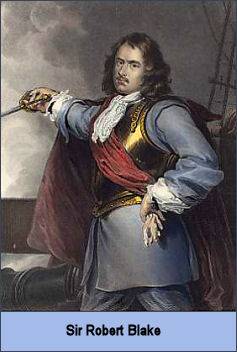Cromwell's Castle
OS grid reference :- SV 881 159

 Standing on a rocky promontory guarding the scenic anchorage between the islands of Bryher and Tresco, the round tower of Cromwell's Castle is one of the few surviving Cromwellian fortifications in Britain, constructed after the Parliamentary conquest of the Scillies by Admiral Sir Robert Blake in 1651.
Standing on a rocky promontory guarding the scenic anchorage between the islands of Bryher and Tresco, the round tower of Cromwell's Castle is one of the few surviving Cromwellian fortifications in Britain, constructed after the Parliamentary conquest of the Scillies by Admiral Sir Robert Blake in 1651.
During the period of the English Civil War which occured between 1642 and 1646, the Isles of Scilly had been staunch supporters of the Royalist cause of King Charles I, and rose in rebellion against Parliament in 1648. Tresco was to become a base for Royalist privateers and Parliament became concerned that the Dutch, then hostile to England, might exploit the situation. In 1651 Parliament despatched Admiral Sir Robert Blake and a naval force to reconquer the island.
On re-establishing control of Tresco , Sir Robert Blake built Cromwell's Castle, a tall cylindrical building, which was named in honour of the Parliamentary leader Oliver Cromwell. The existing fort, King Charles's Castle, had been constructed in the 1550s but was poorly sited and had been largely blown up by its Royalist defenders when Blake's forces took the island.
 In 1715 the engineer Christian Lilly described Cromwell's Castle as:- “Standing at the Foot of a Steep hill much higher than its Top, and is a Huge Mass of Masonry, consisting of a Round Tower two Storys high, with a Platform for six Gunns upon it, and a Battery before it for Six more at the Watters Edge".
In 1715 the engineer Christian Lilly described Cromwell's Castle as:- “Standing at the Foot of a Steep hill much higher than its Top, and is a Huge Mass of Masonry, consisting of a Round Tower two Storys high, with a Platform for six Gunns upon it, and a Battery before it for Six more at the Watters Edge".
The castle comprises of a two-storey tower, measuring 20-feet (6.1 metres) wide and 50-feet (15 metres) in height , with 13 feet thick walls. Six gun-ports allowed the battery a good angle of fire across the channel between the islands of Bryher and Tresco.
The guns were mounted on the roof above the garrison's living quarters and magazines. The tower was originally entered at first floor level by an external stair on the south side. In the jambs of the windows there is a wealth of graffiti including some initials that may have been left by soldiers manning the castle in the eighteenth century.
In 1739 the War of Jenkins' Ear broke out between Britain and Spain, and the decision was taken to improve the defences at Cromwell Castle. A large gun-platform for a battery of six guns was constructed to the south-west of the tower, and other improvements were made.
The castle is now in the care of English Heritage and is open to the public.